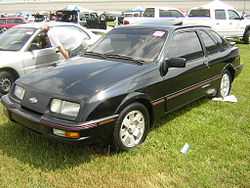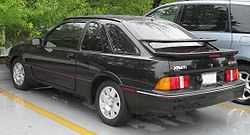Merkur XR4Ti
| Merkur XR4Ti | |
|---|---|
 | |
| Overview | |
| Manufacturer | Karmann |
| Production | 1984-1989 |
| Model years | 1985-1989 |
| Assembly | Osnabrück, Germany |
| Body and chassis | |
| Class | Compact car |
| Body style | 3-door hatchback |
| Layout | FR layout |
| Related |
Ford Sierra Ford Scorpio Merkur Scorpio |
| Powertrain | |
| Engine | 2.3 L turbocharged Lima I4 |
| Transmission |
5-speed T-9 manual 3-speed C3 automatic |
| Dimensions | |
| Wheelbase | 102.7 in (2,609 mm) |
| Length | 178.4 in (4,531 mm) |
| Width | 68 in (1,727 mm) |
| Height | 53.8 in (1,367 mm) |
| Chronology | |
| Predecessor | Mercury LN7 |

The Merkur XR4Ti was a short-lived United States and Canada-market version of the European Ford Sierra XR4i. It was the brainchild of then Ford Vice President Bob Lutz. It was sold in the US from 1985 to 1989. It was the first vehicle of Ford's Merkur range, followed in 1988 by the Merkur Scorpio. Ford had hopes of importing its top European models under this brand, including the Sierra Sapphire but the venture was ultimately unsuccessful due to branding issues, increasing Deutsche Mark exchange rates, generally poor marketing tactics and the introduction in 1990 of new safety requirements such as airbags that would have increased retooling and production costs.
History
The cars were hand assembled and built entirely by Karmann Coachworks in Rheine, Germany.[1] Unlike with the Scorpio, the XR4Ti didn't carry over the Sierra badge from Europe, since at the time it was also being used by General Motors in North America for two completely different vehicles: the GMC Sierra and the similar sounding Oldsmobile Cutlass Ciera. When first introduced, the XR4Ti had a starting price of US$16,503 (equal to about $37,082 today).
The XR4Ti was distinguished mechanically by its turbocharged Ford Lima 2.3 L 4-cylinder SOHC engine and independent rear suspension, and stylistically by its large bi-plane spoiler (replaced in later years with a single rear spoiler). It came with either the C3 3-speed automatic transmission or the Ford Type 9, 5-speed manual transmission. Mechanically, it differed from the European Ford Sierra XR4i, which had a 2.8l Ford Cologne V6. Airbag legislation for the 1990 model years and weak sales as are frequently cited as the cause for the Merkur range to be discontinued.
The XR4Ti was on Car and Driver's Ten Best list for 1985. In 2009 however, the magazine's staff apologized for including the XR4Ti in their 1985 "Ten Best" list, and effectively recanted the award.[2]
| Year | Units |
|---|---|
| 1985 | 12,400 |
| 1986 | 13,599 |
| 1987 | 7,342 |
| 1988 | 6,283 |
| 1989 | 2,870 |
| Total | 42,464 |
Engines
The XR4Ti came with one engine, the 2.3 liter turbocharged, in-line, fuel injected 'Lima' four cylinder using an EEC-IV computer. The 4-cylinder engine was generally rated at 145 hp (108 kW) when mated with an automatic transmission (8 to 10 lbf/in² [55 to 70 kPa] boost), and 175 hp (130 kW) when matched with the 5-speed manual transmission (12 to 14 lb (6 kg). boost). This engine is the same as is found in the SVO Mustang and the Thunderbird Turbo Coupe of the time, though the SVO Mustang and 1987-88 Thunderbird Turbo Coupe differed by having an intercooler and different EEC-IV programming.
Options
The XR4Ti extra cost options initially included three-speed automatic transmission, power windows/central locking group, cruise control, leather seats, heated seats, power moonroof (retractable, tinted glass), and metallic paint. Typically ordered options like power windows/central locking group and cruise control eventually became standard.
Updates
In its short life, the XR4Ti saw some minor changes either by design or by implemented TSB. Examples include: uprated heater cores, larger rear hatch glass, improved steering rack, upgraded dash construction etc. Many of these parts were taken from the Sierra Mk.II body shell which was only sold in continental Europe with some being Merkur specific parts. Most of these changes occurred in the 1987 model year.
Performance
The top speed of the manual transmission XR4Ti 1985-87 was 130 mph (210 km/h). The bi-plane rear spoiler was changed to a single spoiler for the 1988-1989 cars; it actually increased the drag coefficient compared to the bi-plane spoiler of the earlier cars which have a coefficient of 0.32.
Car & Driver tests for the XR4Ti reported 0-60 mph times from 7 seconds flat and as high 7.9 seconds and 1/4 mile times at around 15.7 seconds. Later tests by Car & Driver showed 7.8 seconds for the 0-60 mph times and they mentioned the press car might have been a ringer which was common at the time. In their test data, they initially stated the car came with a limited slip differential which was a misprint, at the time there were no LSD's available in either the American Merkur XR4Ti or its sister car the Europe-only XR4i. It wasn't until the introduction of the European only XR4x4 and Cosworth Sierra that an LSD was offered from the factory.
Motorsport

Despite the XR4Ti never being sold outside the United States and Canada, in 1985, Andy Rouse used one to compete in the British Saloon Car Championship. He took the overall title for that year and the class title for the following year with 14 race victories altogether.[4] In 1986 Eggenberger Motorsport was among the few to use an XR4Ti to compete in the ETCC and the DTM (German Touring Car Championship) with positive results. Ford would use the car's technical feedback from the teams to develop the super car version of the Sierra in 1986, the Ford Sierra RS Cosworth which was introduced to race tracks in 1987, though its life was short as it was superseded in mid-1987 by the Ford Sierra RS500. Some of the body panels used to stiffen the Sierra chassis and create the Merkur shell were subsequently branded 909 Motorsport parts for later adaptation to a Sierra shell. Many see the successes and failures of the XR4Ti as being the blueprint for success of the dominant RS500 Sierra's.
Between 1986 and 1987, Wally Dallenbach, Jr. and Scott Pruett campaigned the Roush prepped XR4Ti, although of a tubeframe construction like that of a NASCAR racer, to take the Trans-Am Series title.
See also
References
- ↑ Büschi, Hans-Ulrich, ed. (9 March 1989,). Automobil Revue 1989 (in German/French) 84. Berne, Switzerland: Hallwag AG. pp. 398–399. ISBN 3-444-00482-6.
- ↑ "Dishonorable Mention: The 10 Most Embarrassing Award Winners in Automotive History". Autos.yahoo.com. Retrieved 2012-01-13.
- ↑ "Thompson, Richard. Merkur Knowledge Base, Version 2.15" (PDF). Retrieved 2012-01-13.
- ↑ BTCCPages.com. "Drivers - Andy Rouse". BTCC Pages. Retrieved 2012-01-13.
External links
- Merkur Desktop a directory of webpages related to Merkur
| Merkur road car timeline, 1985-1989 | ||||||||||
| 1980s | ||||||||||
| 5 | 6 | 7 | 8 | 9 | ||||||
| Compact | XR4Ti | |||||||||
| Mid-size | Scorpio | |||||||||